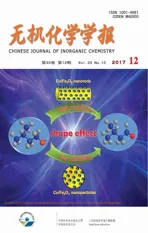MgH2-MoS2-PP复合材料的储氢性能
2017-12-13彭丹丹郭亮亮韩树民
刘 洋 李 媛 彭丹丹 郭亮亮 张 璐 韩树民*,
MgH2-MoS2-PP复合材料的储氢性能
刘 洋1,2李 媛*,2彭丹丹2郭亮亮2张 璐2韩树民*,1,2
(1燕山大学亚稳材料制备技术与科学国家重点实验室,秦皇岛 066004)
(2燕山大学应用化学河北省重点实验室,秦皇岛 066004)
通过球磨法制备了MgH2-MoS2-PP(PP=热解聚苯胺,wMoS2=wPP=8.33%)复合材料。与纯MgH2对比研究发现,复合材料的初始放氢温度从650 K下降到550 K,并且在573 K下,75 min内的放氢量从0.38%(w/w,下同)提高到2.36%。在423 K下,放氢后产物可在40 min内吸氢2.45%,比纯MgH2高出2.13倍。放氢反应的活化能比纯MgH2(101.83 kJ·mol-1)降低了28.81 kJ·mol-1。MgH2-MoS2-PP复合材料的性能提高是由于PP能够均匀地减小Mg颗粒尺寸,并提高MoS2在体系放氢与再吸氢过程中的催化效率。
储氢材料;氢化镁;复合材料;MoS2;热解聚苯胺
0 Introduction
Magnesium hydride(MgH2)is considered as one of the most promising candidates for hydrogen storage due to its high gravimetric(7.65%,w/w)and volumetric(110 gH2·L-1)hydrogen capacity,abundant resources,relatively low cost and good hydriding/dehydriding reversibility[1-4].However,the relatively high thermal stability and poor sorption kinetics have hindered itsapplications[5-7].To solve those issues,considerable efforts have been made in the past decade.One of them is to introduce catalysts,such as transition metals Ti[8-9],V[10]or Ni[11-12],or metallic compounds NbHx[13],Fe3S4[14],or NiFe2O4[15]in Mg-based hydrogen storage materials by ball-milling to reduce Mg-H bonding energy and thus improving the desorption properties of MgH2.However,the desorption temperatures was still too high in those improved systems.For example,Qi et al.[15]have reported that MgH2must be heated to 573 K to desorb 3.79%(w/w)H2within 1 h after adding 7%(n/n)of NiFe2O4.
Other studies have found that Mg-based system desorption rates can be significantly increased with the addition of carbon nanomaterials such as graphene(Gn)[16-17],graphite (Gt)[18-19],activated carbon (AC)[20]and single-walled carbon nanotubes (SWCNT)[21-22].One of the main reasons is that carbon materials can inhibit the agglomeration of Mg particles,resulting from their high surface to volume ratio.Therefore,carbon materials might be an effective additive to improve MgH2hydrogen storage properties.
It has been demonstrated in our studies[23]that hydrogenation performance of MgH2can be significantly enhanced by adding MoS2catalyst.In order to further enhance the desorption-resorption performance of MgH2,a novel pyrolyzed polyaniline (PP)carbon material was obtained,and milled with MgH2and MoS2to prepare an MgH2-MoS2-PP (PP=pyrolyzed polyaniline,wMoS2=wPP=8.33%)composite.By studying the microstructure,hydrogen storage mechanism and properties of the composite,we have found that this composite is excellent in thermodynamic and kinetic properties for hydriding/dehydriding and here we report it as a new hydrogen storage composite material.
1 Experimental
1.1 Preparation of the composite
To prepare pyrolyzed polyaniline (PP),polyaniline (PAN,Alfa Aesar)was heated to 773 K under a hydrogen backpressure of 1 MPa for 12 h.The MgH2was purchased from Sigma Aldrich.
ToprepareMgH2-MoS2-PP composite,MgH2,8.33%PP(w/w,the same below)and 8.33%MoS2were mechanically milled under Ar atmosphere at room temperature using a QM-IPP2 planetary mill at a rotation speed of 450 r·min-1.The sample was milled for a total of 5 h with a 15 min rest period every 30 min.The weight ratio of ball to powder was 30:1.As compared samples,pure MgH2and composites of MgH2-MoS2(wMoS2=16.67%)and MgH2-PP(wPP=16.67%)were milled under the same condition.
1.2 Structural and compositional analysis
X-ray diffraction(XRD)with Cu Kα radiation(λ=0.154 nm,U=40 kV,I=30 mA)was used to determine the phase composition before and after desorption of the samples,with 2θ ranging from 10°to 80°.The morphology of the samples was accessed on an S-4800 Field Emission Scanning Electron Microscope(SEM).
A simultaneous thermal analyzer(DTG-60A)was employed to study the dehydriding performance of the sample under argon atmosphere,from room temperature to 873 K,with a heating rates of 5,10,15 and 20 K·min-1,respectively.
1.3 Hydrogen absorption and desorption measurements
The temperature-programmed desorption(TPD)and dehydrogenation-rehydrogenation kinetic studies were performed in a characteristic pressure-composition-temperature (P-C-T) measurement apparatus.Approximately 500 mg sample was loaded into a vessel in the glovebox.For TPD test,the sample was heated in a vacuum chamber from room temperature to 823 K with a heating rate of 5 K·min-1.The dehydrogenation kinetic tests were done at 300 K with an initial hydrogen pressure of 0.01 MPa.To study rehydrogenation kinetics,the samples were kept at 423 K under 3.0 MPa hydrogen pressure for 1 h after completing dehydrogenation at 623 K.
2 Results and discussion
2.1 XRD pattern and microstructure of PP
Fig.1 shows the XRD pattern and SEM micrograph of PP after pyrolyzation.The two peaks around 25°and 42°are amorphous.SEM shows that PP with high specific surface area provides sufficient diffusion channels for the hydrogen atoms during the resorption-desorption process.At the same time,lots of defect sites are formed which might be good for the dispersion of Mg particles.
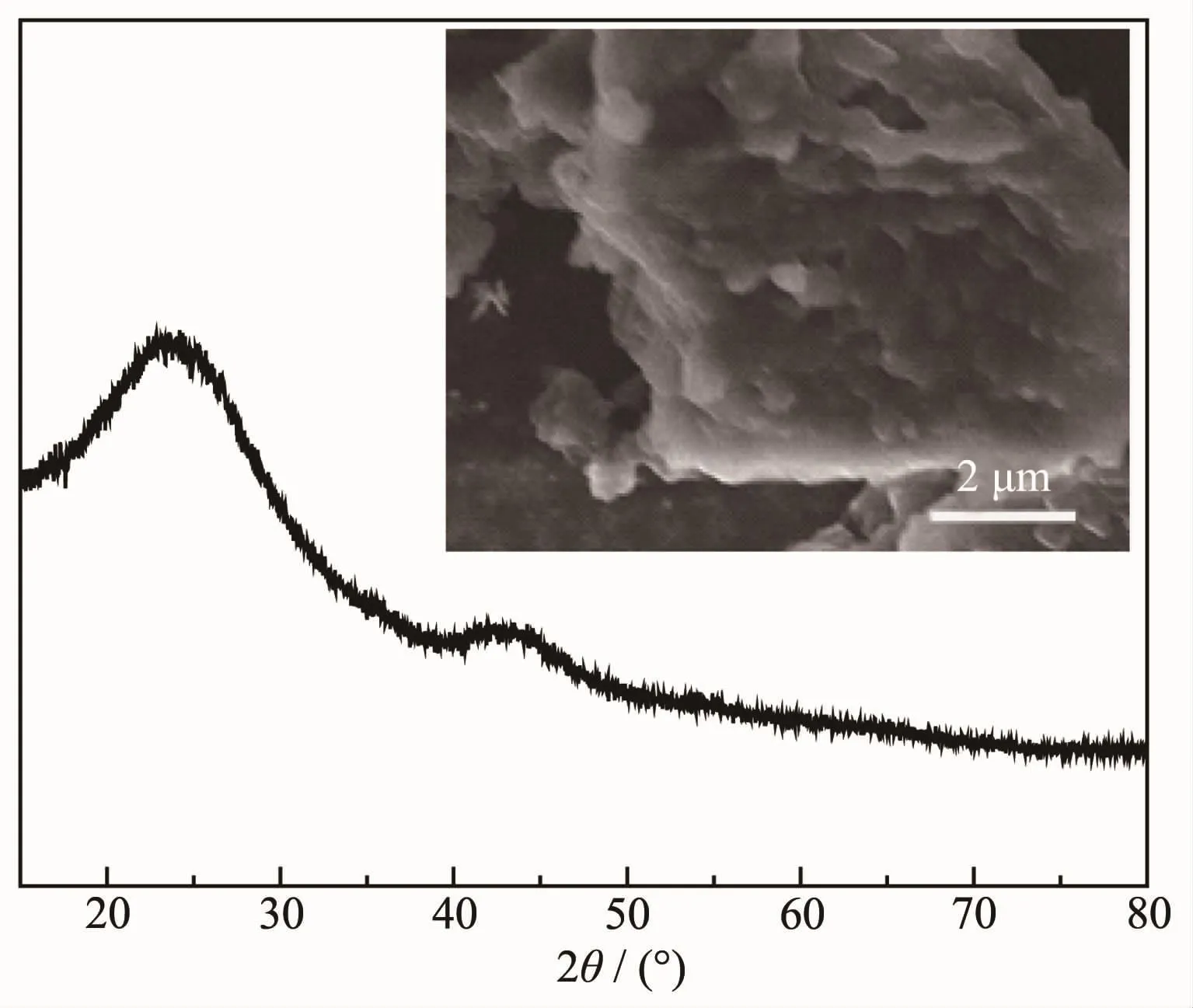
Fig.1 XRD pattern and SEM micrograph of PP
2.2 Hydrogen storage properties of MgH2-MoS2-PP composite
Fig.2 shows the TPD profiles for desorption of the pure MgH2,MgH2-PP,MgH2-MoS2and MgH2-MoS2-PP composites.The onset decomposition temperatures of the MgH2composites decrease from 650 K(pristine MgH2)to 600,575 and 550 K,after adding PP,MoS2and MoS2-PP,respectively.The remarkable decrease in onset decomposition temperature suggests that MgH2is destabilized by ball-milled with PP,MoS2and PP-MoS2.However,all the composites release less hydrogen with hydrogen released decreasing from 6.0%to 5.0%,which is ascribed to that additives cannot absorb hydrogen.
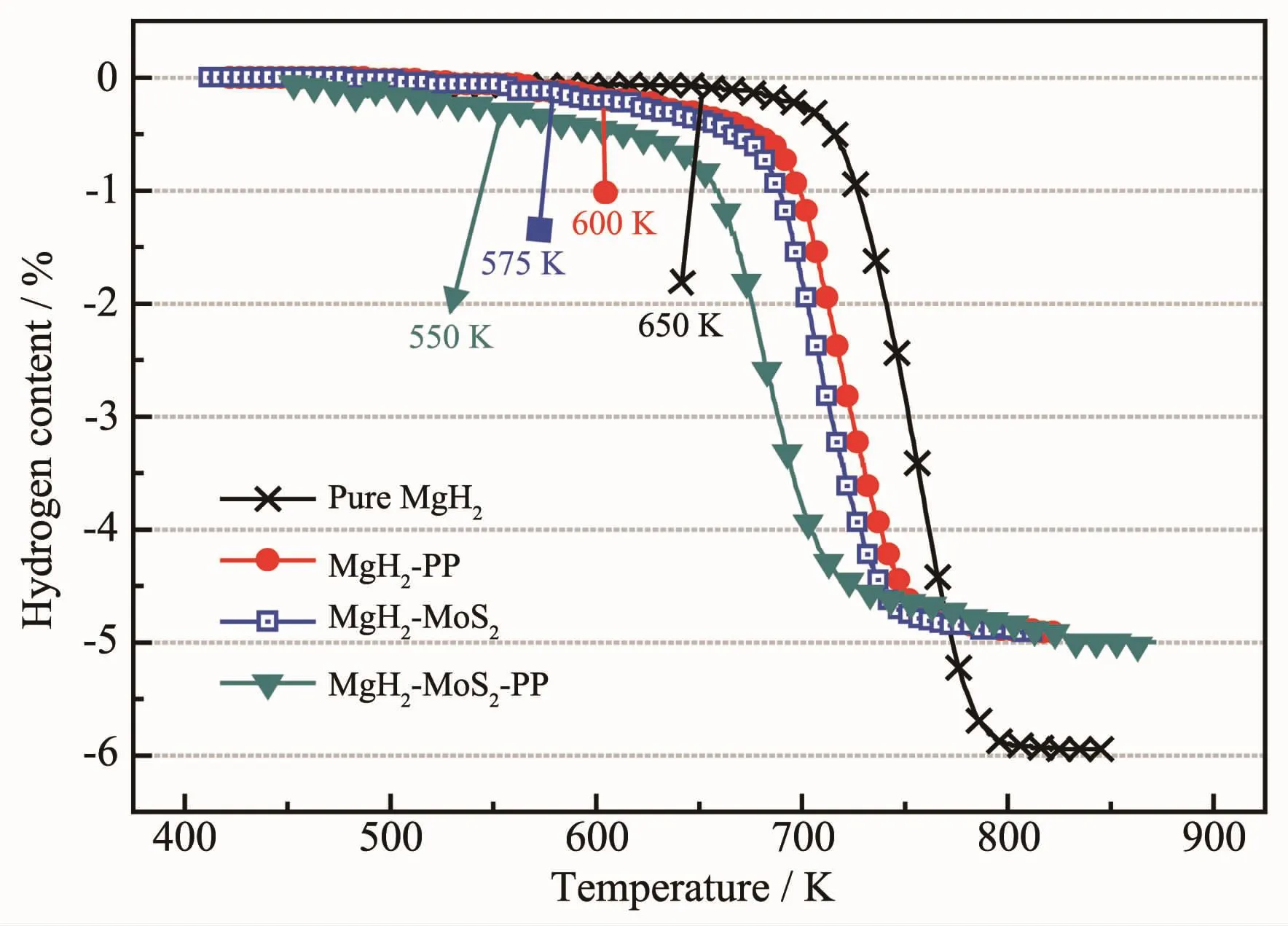
Fig.2 TPD curves of the pure MgH2and the composites of MgH2-PP,MgH2-MoS2and MgH2-MoS2-PP
To further understand the effects of PP,MoS2and MoS2-PP additions,the isothermal desorption kinetics oftheMgH2-PP,MgH2-MoS2andMgH2-MoS2-PP composites were studied,as presented in Fig.3.The pure MgH2sample only releases 0.38%hydrogen after 75 min at 573 K,while the MgH2-PP,MgH2-MoS2and MgH2-MoS2-PP composite release 0.76%,0.88%and 2.36%hydrogen under the same condition,respectively.The fastest desorption kinetics is found in the composite with the addition of both MoS2and PP,indicating a synergistic effectbetween the two additives,which is to be explained subsequently.

Fig.3 Desorption curves of pure MgH2,MgH2-PP and MgH2-MoS2-PP composites at 573 K
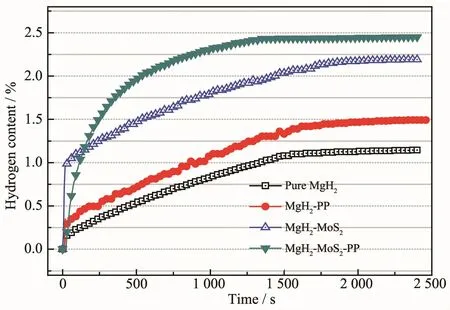
Fig.4 Hydriding curves of pure MgH2,MgH2-PP,MgH2-MoS2and MgH2-MoS2-PP composites
Fig.4 shows the hydrogen absorption curves of MgH2,MgH2-PP,MgH2-MoS2and MgH2-MoS2-PP composites at 423 K under a hydrogen pressure of 3.0 MPa.It can be seen that all the three composites absorb hydrogen faster than pure MgH2.In specific,the pure MgH2only absorbs 1.15%of hydrogen within 40 min,while the MgH2-PP,MgH2-MoS2and MgH2-MoS2-PP samples absorb 1.50%,2.20%and 2.45%of hydrogen in the same period,respectively.It is noticeable that MgH2-MoS2-PP sample exhibits the highesthydrogen absorption rate.These results suggestthatthe PP and MoS2additives can synergistically improve dehydrogenation kinetics of MgH2. To better understand this synergistic mechanism between PP and MoS2,we performed further studies and the results are discussed below.
2.3 Phase composition and microstructure of MgH2-MoS2-PP composite
To further understand the improvement after PP,MoS2and PP-MoS2additions,phase structures of the samples were studied using XRD.As to MgH2-PP sample,the XRD patterns of samples as-milled,after hydrogenation and after dehydrogenation (Fig.5)are similar to pure MgH2in our previous study[23].And a new compound of MgS formed after ball-milling in the MgH2-MoS2-PP sample(Fig.6)which is similar to MgH2-MoS2[23].Also,peaks of low intensity of MgO were observed in the MgH2-MoS2-PP,which is probably due to the air and moisture contamination.
Based on the XRD analysis and our previous work[23],the possible reaction pathways of MgH2-PP could be the same as those of the pure MgH2.However the MgH2-MoS2-PP sample is concluded in a different way,as shown in equations 1 and 2.It is to our knowledge that the related decomposition enthalpy of MgH2is 75 kJ·mol-1[24].This provides the possibility of the reaction from the thermodynamic potentials,as explained later in equation 3.
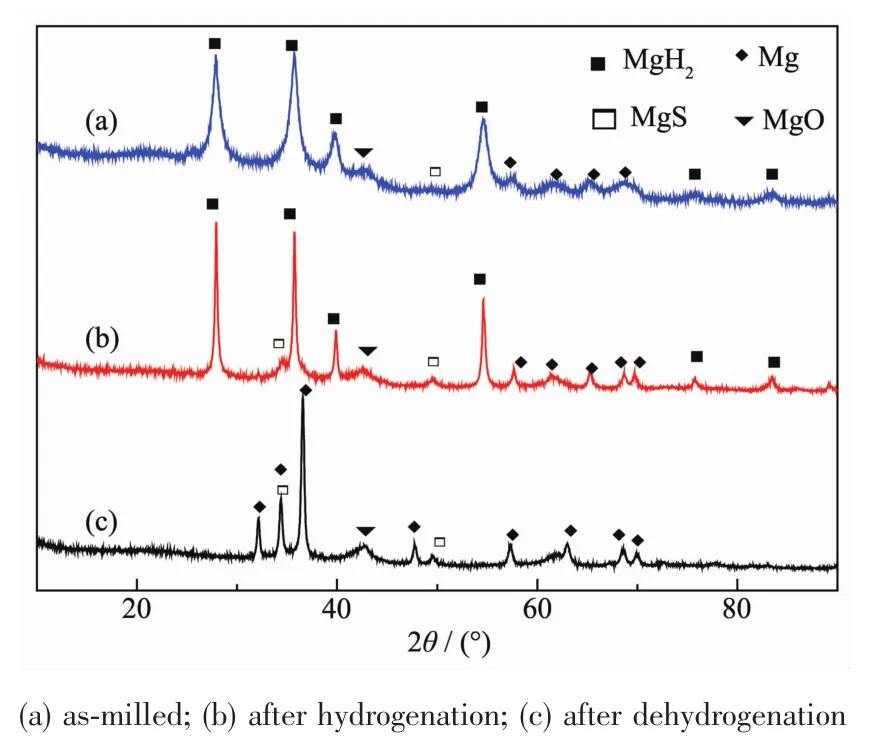
Fig.5 XRD patterns of MgH2-PP composite
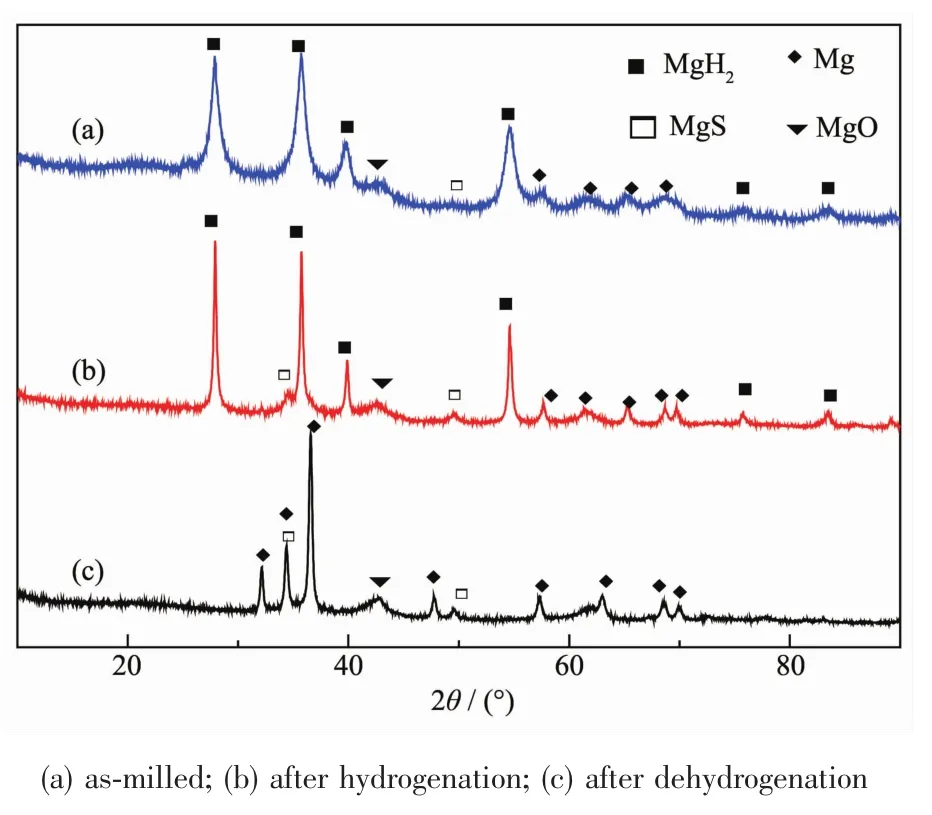
Fig.6 XRD patterns of MgH2-MoS2-PP composite

SEM was used to image the surface microtopography of the MgH2-MoS2-PP composite before and after hydrogen desorption.Fig.7 shows the SEM micrographs ofMgH2-MoS2-PP and pure MgH2samples.After ball-milling,the average particle size of the MgH2-MoS2-PP composite is smaller than 500 nm,which is smaller than that of pure MgH2.Both MgH2and MoS2are attached on the surface of PP,as demonstrated in Fig.6(b). After dehydrogenation at 623 K,Mg particles attached on the PP have shown less agglomeration.It is well known that the hydrogen storage properties of light metal hydrides can be improved with reduced particle agglomeration.Therefore,it is speculated that the hydrogen storage properties of the MgH2-MoS2-PP sample are improved as a result of the presence of PP and MoS2.PP is able to disperse Mg/MgH2particles well in the system by forming a large number of nucleation sites at their surface and MoS2could be beneficial to the dehydrogenation of MgH2.
2.4 Decomposition activation energy of MgH2-MoS2-PP composite
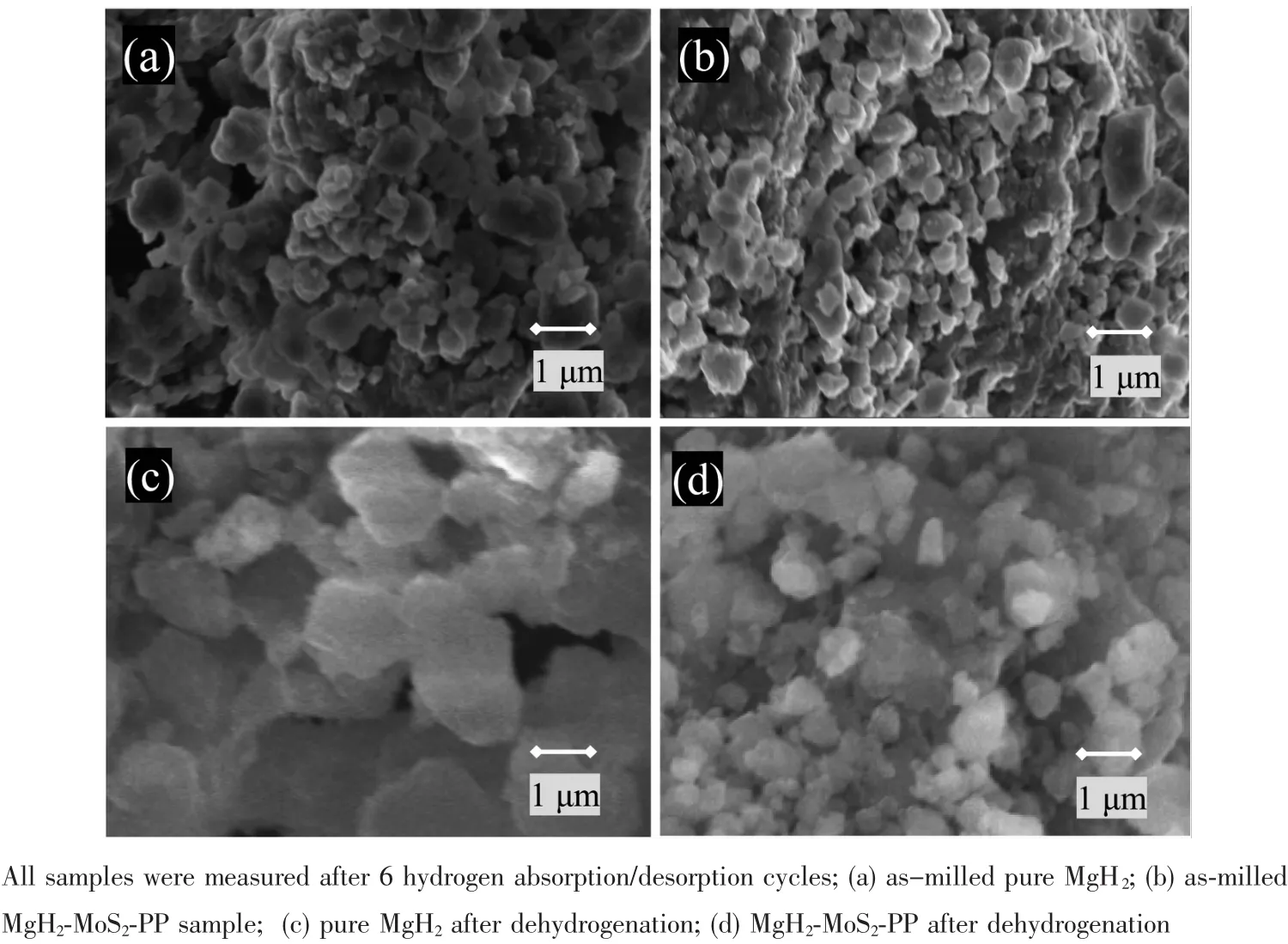
Fig.7 SEM micrographs of the samples
The hydrogen desorption kineticscurvesof differentsamples at various heating rates are presented in Fig.8.It can be observed that the desorption curve for the MgH2shows only one strong endothermic process,which corresponds to decomposition of MgH2.At a heating rate of 5 K·min-1,the curve for MgH2-MoS2-PP shows an endothermic peak at 601.94 K,which is 65.59 K lower than that of pristine MgH2,indicating that the MgH2-MoS2-PP composite is able to release hydrogen at a lower temperature.
To compare the activation energy values of the MgH2and the MgH2-MoS2-PP composite,the Kissinger analysis is used as follows[25]:

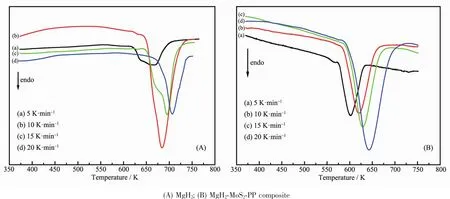
Fig.8 DTA curves of different samples at various heating rates
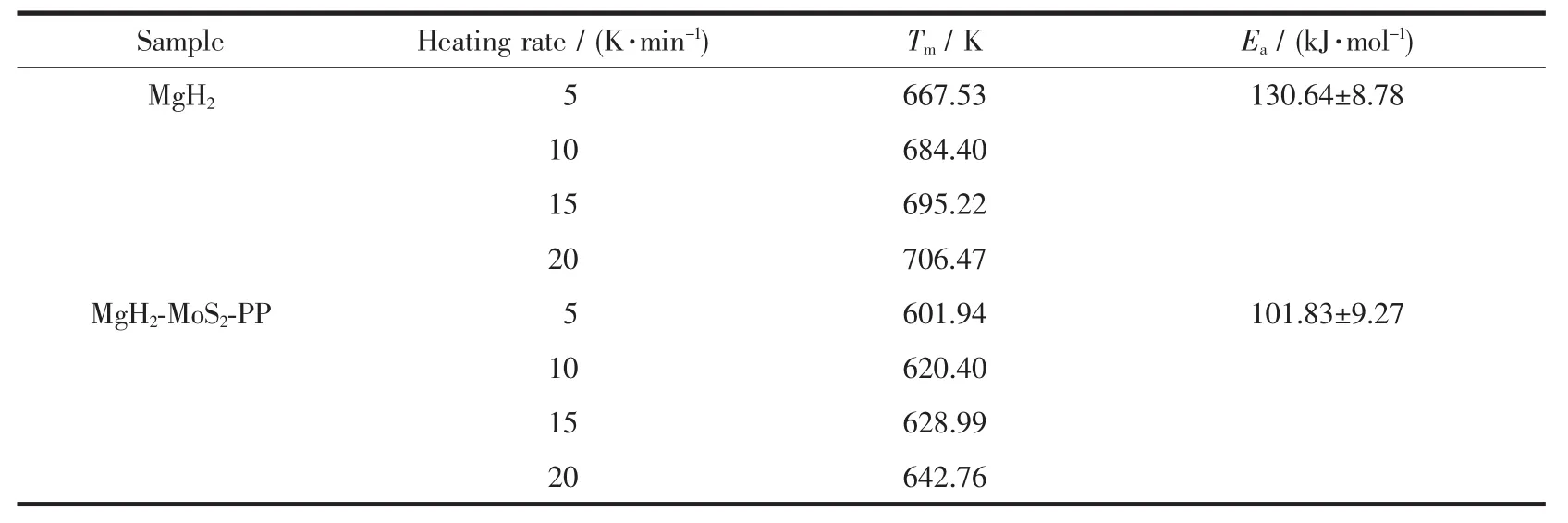
Table 1 Tmand Eacorresponding MgH2and MgH2-MoS2-PP samples
where α is the heating rate;Tmis the absolute temperature at the maximum desorption rate;Eais the activation energy and R is the ideal gas constant.The activation energy values of MgH2and MgH2-MoS2-PP composite are evaluated from the DTA data according to the Kissinger formula.In Fig.8,Tmis obtained as the peak temperature.And then plot of ln(α/Tm2)versus 1 000/Tmin Fig.9 can be obtained,showing as a good linear form.Subsequently,activation energy Eavalues are calculated and listed in Table 1.In comparison with pure MgH2,the activation energy of the composite in decomposition process is reduced by 28.81 kJ·mol-1.In addition,our previous work had showed that the activation energy could be decreased by 23.84 kJ·mol-1when MoS2was added to MgH2[23].Both of the results demonstrate that MoS2additions can decrease the energy barrier of MgH2in the hydrogen desorption process.
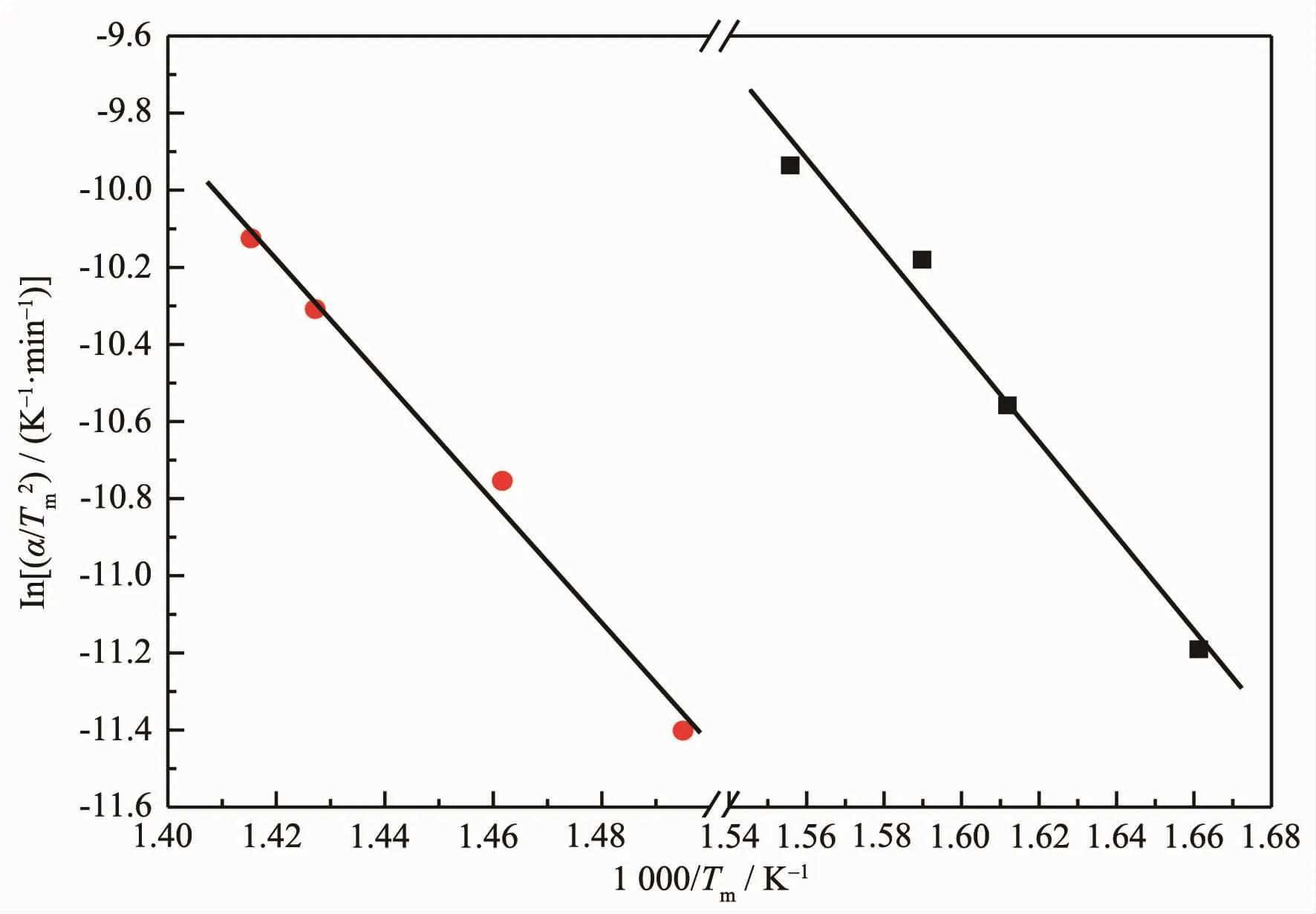
Fig.9 Kissinger plot of first-order dehydrogenation of different samples at various heating rates
Based on these data above,PP and MoS2show a synergistic enhanced effect for dehydrogenation of MgH2.PP has high surface area and defect sites which could provide the sufficient diffusion channels for hydrogen atoms.After ball-milling and subsequent dehydrogenation,crystalline magnesium with smaller sizes and less agglomeration distribute on the PP surface.At the same time,Mo and MgS2can be formed because of MoS2addition.As a result,MgH2-MoS2-PP composite exhibits superior hydrogen storage performance.
3 Conclusions
In this study, MgH2-MoS2-PP composite was synthesized by ball-milling,and it shows significantly improved hydrogen storage properties.TPD testing demonstrates that the onset desorption temperature of the composite is decreased by 100 K.Also,in terms of the sorption/desorption kinetics,the MgH2-PP-MoS2system releases approximately 2.36%(w/w)hydrogen at 573 K in 70 min and absorbs 2.45%(w/w)hydrogen in 20 min,which are faster than pure MgH2.Eaof composite is found to decrease by 28.81 kJ·mol-1compared to that of MgH2,which indicates that MgS2has great catalytic action to MgH2.The enhancement of hydrogen storage properties of the composite is mainly because of the synergism of the catalytic effect of MgS2and the dispersive action of PP to Mg particles.
[1]Schlapbach L,Züttel A.Nature,2001,414:353-358
[2]MA Jian-Li(马 建 丽),WANG Yan(王 艳),TAO Zhan-Liang(陶占良),et al.Chinese J.Inorg.Chem.(无机化学学报),2012,28(4):657-661
[3]Dolci F,Chio M D,Baricco M,et al.J.Mater.Sci.,2007,42:7180-7185
[4]Fan M Q,Liu S S,Zhang Y,et al.Energy,2010,35:3417-3421
[5]Ismail M.Energy,2015,79:177-182
[6]Wang J C,Du Y,Sun L X,et al.Int.J.Hydrogen Energy,2014,39:877-883
[7]Lu J,Choi Y J,Fang Z Z,et al.J.Am.Chem.Soc.,2009,131:15843-15852
[8]Shao H,Felderhoff M,Schüth F,et al.Nanotechnology,2011,22:2471-2478
[9]Shang C X,Bououdina M,Song Y,et al.Int.J.Hydrogen Energy,2004,29:73-80
[10]Dehouche Z,Goyette J,Bose T K,et al.Nano Lett.,2001,1:175-178
[11]Shimada M,Tamaki H,Higuchi E,et al.J.Mater.Sci.,2013,48:7312-7319
[12]Sun G L,Li Y Y,Zhao X X,et al.RSC Adv.,2016,6:23110-13116
[13]Zhang L T,Xiao X Z,Xu C C,et al.J.Phys.Chem.C,2015,119:8554-8562
[14]Zhang W,Cheng Y,Han D,et al.Energy,2015,93:625-630
[15]Wan Q,Li P,Shan J W,et al.J.Phys.Chem.C,2015,119:2925-2934
[16]Zhang H P,Luo X G,Lin X Y,et al.Chem.Phys.Lett.,2015,623:82-88
[17]Zhang J,Yu X F,Mao C,et al.Energy,2015,89:957-964
[18]Fuster V,Urretavizcaya G,Castro F J.J.Alloys Compd.,2009,481:673-680
[19]Huang Z G,Guo Z P,Calka A,et al.Mater.Sci.Eng.A,2007,447:180-185
[20]Jia Y,Guo Y N,Zou J,et al.Int.J.Hydrogen Energy,2012,37:7579-7585
[21]Hwang S J,Chuang Y S.J.Alloys Compd.,2016,664:284-290
[22]Pandyan R K.Int.J.Hydrogen Energy,2011,36:3007-3015
[23]Jia Y H,Han S M,Zhang W,et al.Int.J.Hydrogen Energy,2013,38:235-2356
[24]Wang H,Zhong H C,Ouyang L Z,et al.J.Phys.Chem.C,2014,118:12087-12096
[25]Kissinger H E.Anal.Chem.,1957,29:1702-1706
Hydrogen Storage Properties of MgH2-MoS2-Pyrolyzed Polyaniline Composite
LIU Yang1,2LI Yuan*,2PENG Dan-Dan2GUO Liang-Liang2ZHANG Lu2HAN Shu-Min*,1,2
(1State Key Laboratory of Metastable Materials Science and Technology,Yanshan University,Qinhuangdao,Hebei 066004,China)
(2Hebei Key Laboratory of Applied Chemistry,School of Environmental and Chemical Engineering,Yanshan University,Qinhuangdao,Hebei 066004,China)
A composite of MgH2-MoS2-PP (PP=pyrolyzed polyaniline,wMoS2=wPP=8.33%)was prepared by ballmilling.In comparison to pure MgH2,the onset decomposition temperature of the composite decreases from 650 to 550 K and the hydrogen desorption content increases from 0.38%to 2.36%(w/w,the same below)at 573 K within 75 min.The composite can absorb 2.45%H2within 40 min,which is 2.13 times higher than that of the MgH2at 423 K.The apparent activation energy of the composite is 101.83 kJ·mol-1,decreasing by 28.81 kJ·mol-1compared to MgH2.The reason of superior hydrogen storage performance of the PP-MoS2-MgH2composite is found to be that PP can effectively decrease the size of Mg particles and enhance the catalytic efficiency of MoS2in the desorption-resorption cycling.
hydrogen storage material;magnesium hydride;composite;MoS2;pyrolyzed polyaniline
TB333;O614.22;O614.61+2
A
1001-4861(2017)12-2296-07
10.11862/CJIC.2017.278
2017-05-16。收修改稿日期:2017-08-09。
国家自然科学基金(No.50971112,51471065)和河北省高等学校科学技术研究重点项目(No.ZD2014004)资助。
*通信联系人。 E-mail:liyuan@ysu.edu.cn,hanshm@ysu.edu.cn
